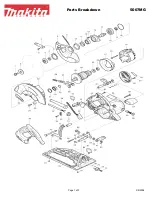
6
7
Changing Blades
1. R E M O V E B AT T E R Y PA C K B E -
FORE CHANGING OR REMOVING
BLADES.
2. Turn the tension lock handle located on
the front of the saw 180° counterclock-
wise. This releases the tension on the
blade for easy removal.
3.
Remove the blades from the pulleys fi rst
and then from the guides.
4. To install a new blade, with the pulleys
facing up, insert the blade between the
rollers and the faces of the guides, mak-
ing sure that the teeth on the left side
of the tool point towards the rear of the
tool.
5. With one hand, hold the blade in place
between the rollers and the guides and
use the other hand to position the blade
around the pulleys. Be sure that the
blade lies freely within the guard channel
before starting the tool motor.
6.
Turn the tension lock handle 180° clock-
wise to lock the position. This will secure
the blade on the pulleys.
BE SURE THAT THE BLADE IS PROP-
ERLY SEATED ON THE PULLEYS
BEFORE STARTING THE CUT.
WARNING
OPERATION
To reduce the risk of injury, keep hands
away from the blade and other moving
parts. Always wear safety goggles or
glasses with side shields.
High/Low/Trigger Lock Switch
To set the maximum speed or lock the trigger,
allow the motor to come to a complete stop
then move the high/low/trigger lock switch to
the following positions:
For
low
speed (Maximum 225 SFPM): Push
in the control switch from the left side of the
tool. To vary the speed up to 225 SFPM, in-
crease or decrease pressure on the trigger.
For
high
speed (Maximum 350 SFPM):
Push in the control switch from the right
side of the tool. To vary the speed up to 350
SFPM, increase or decrease pressure on
the trigger.
To
lock
the trigger: Push the control switch
to the center position. The trigger will not
work while the switch is in the locked posi-
tion. Always lock the trigger and remove the
battery pack before performing maintenance
and when changing accessories. Lock the
trigger when storing the tool and when the
tool is not in use.
Fig. 3
Low Speed
Max 225 SFPM
High Speed
Max 350 SFPM
Trigger
Lock
Starting, Stopping and Controlling
Speed
1. To
start
the tool, grasp the trigger handle
and front handle fi rmly and pull the trig-
ger.
Note: LED light turns on when the
trigger is pulled.
2. To
vary
the speed, increase or de-
crease the pressure on the trigger. The
further the trigger is pulled, the greater
the speed. The maximum SFPM is
determined by the high/low/trigger lock
switch.
3. To
stop
the tool, release the trigger. Al-
low the tool to come to a complete stop
before removing the blade from a partial
cut or laying the tool down.
Electric Brake
The electric brake engages when the trigger
is released, causing the blade to stop and al-
lowing you to proceed with your work. Gener-
ally, the saw blade stops within two seconds.
However, there may be a delay between
the time you release the trigger and when
the brake engages. Occasionally the brake
may miss completely. If the brake misses
frequently, the saw needs servicing by an
authorized
MILWAUKEE
service facility.
Fig. 4
Correct
Incorrect
Typical Application
1. Keep the blade off the workpiece until
the motor has reached the selected
speed.
2. Start cutting on a surface where the
greatest number of teeth will be in
contact with the workpiece at one time
(Fig 4).
3. Place the work steady rest against the
workpiece and lower the moving saw
blade into the cut.
4. Do not bear down while cutting. The
weight of the tool will supply adequate
pressure for the fastest cutting.
5. When completing a cut, hold the tool
fi rmly so it will not fall against the work-
piece.
Cold Weather Operation
The
V28
Lithium-Ion battery pack can be
used in temperatures down to -4°F. When
the battery pack is very cold, it may pulse for
the fi rst minute of use to warm itself up. Put
the battery pack on a tool and use the tool in
a light application. After about a minute, the
pack will have warmed itself up and operate
normally.

































